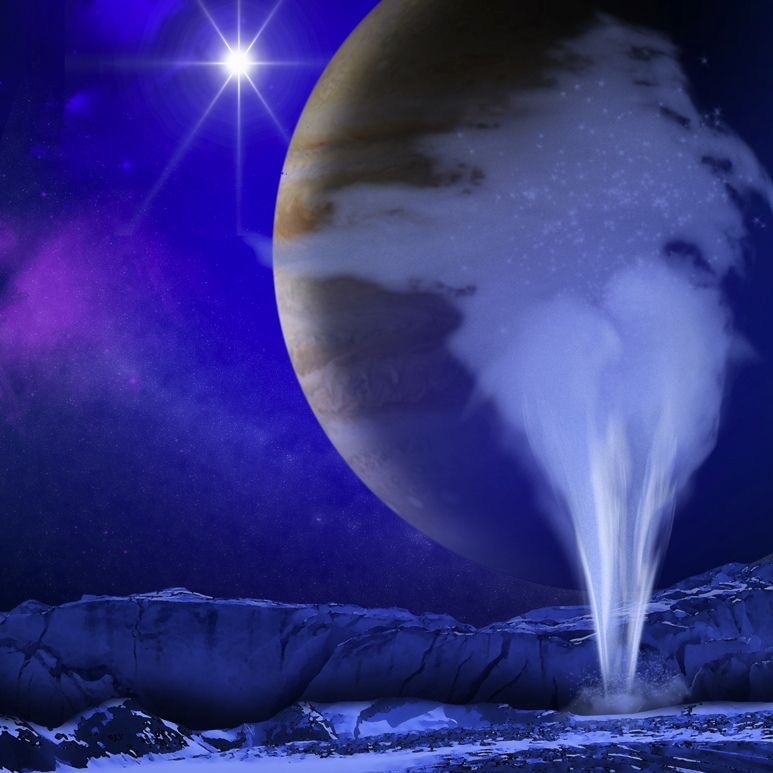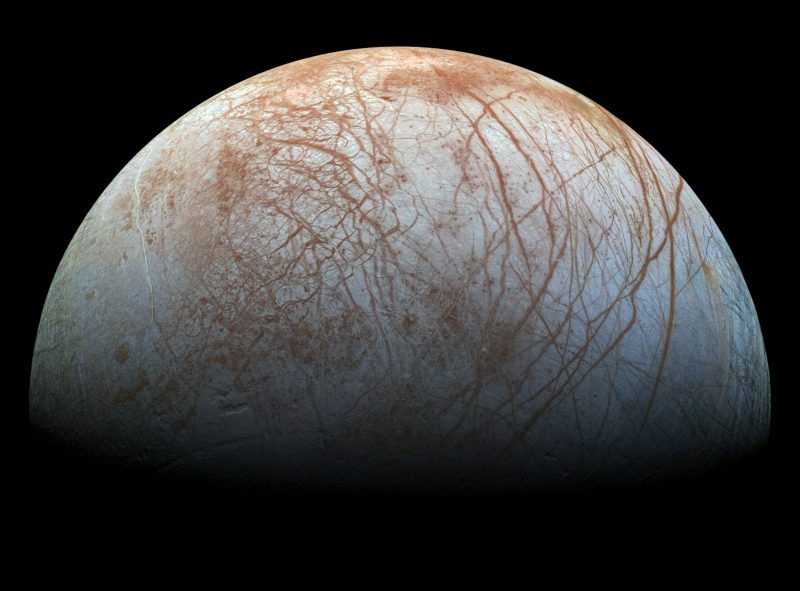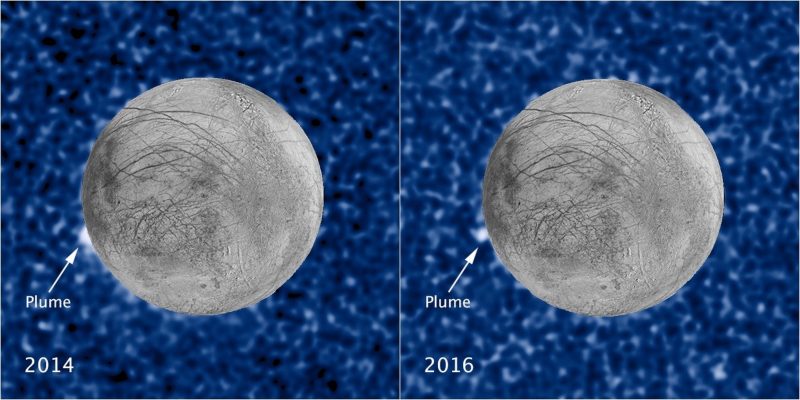
The huge plumes of water vapor erupting through enormous cracks in the surface of Saturn’s moon Enceladus were quickly found by the Cassini spacecraft after it began orbiting Saturn in 2004. They’re thought to arise from a salty global ocean below the moon’s ice crust. Over the past few years, evidence has been accumulating for watery plumes on Jupiter’s large ocean moon Europa, too. It’s taking longer to put the pieces of the puzzle together, but – although still not definitive – the data for plumes on Europa are beginning to look compelling. They indicate that geyser-like plumes erupt from Europa’s surface, at least occasionally. On May 12, 2020, researchers at the Max Planck Institute for Solar System Research (MPS) in Germany and the European Space Agency (ESA) reported yet more evidence for water plumes on Europa.
The new work supports previous studies that suggested that – although it wasn’t recognized at the time – NASA’s Galileo spacecraft glimpsed one of these plumes during a flyby of Europa in 2000. The researchers published their work in Geophysical Research Letters in late April.
Making the case for plumes on Europa has been a long process, since, from the evidence gathered so far, they are seemingly intermittent. In contrast, the plumes on Enceladus were large and easy to see and, at least at the time, were erupting continuously. MPS scientist Elias Roussos said in a statement:
However, various theories, models, and sporadic observations suggest that Europa, too, can exhibit plumes.

How did the researchers find further evidence for Europa’s plumes?
They used computer simulations to replicate the data from the Energetic Particles Detector (EPD) onboard Galileo during a flyby of Europa in 2000. EPD recorded the distribution of high-energy protons trapped in Jupiter’s powerful magnetic field, which is 20 times stronger than Earth’s. Europa orbits within that magnetic field. Back in 2000, the detector recorded fewer protons during the flyby than had been expected. At the time, it was thought that Europa itself was blocking the view of the detector.
But now the new study suggests something else. The researchers modeled the movements of protons during the flyby, in an attempt to reproduce the original results from Galileo. But – surprise – they found that the only model that matched the results was one where a water vapor plume was between Europa and the detector.

The plume would have disrupted both Europa’s extremely thin atmosphere and the magnetic field. This also would have changed the amount and behavior of the energetic protons. When the protons collided with uncharged particles from Europa’s atmosphere or plume, they took electrons from them, becoming uncharged particles themselves. As Hans Huybrighs from ESA, lead author of the new study, said:
This means they are no longer trapped in Jupiter’s magnetic field and can leave the system at high speed.
Therefore, the decreased number of protons detected during the flyby could be explained by a water vapor plume.
Last year, it was reported that water vapor itself had been directly detected above Europa’s surface by researchers using the W. M. Keck Observatory on Mauna Kea in Hawaii. According to NASA scientist Lucas Paganini:
Essential chemical elements (carbon, hydrogen, oxygen, nitrogen, phosphorus, and sulfur) and sources of energy, two of three requirements for life, are found all over the solar system. But the third – liquid water – is somewhat hard to find beyond Earth. While scientists have not yet detected liquid water directly, we’ve found the next best thing: water in vapor form.
The water vapor signal was faint, however, and only seen once in 17 nights of observations in 2016 and 2017. The Hubble Space Telescope (HST) also took images in 2014 and 2016 that appear to show a plume in the same location. But even that wasn’t considered quite conclusive enough.

Based on this and previous studies, the Europan plumes are probably less frequent and maybe smaller than those on Enceladus. But that doesn’t make them any less exciting. If they occur in a manner similar to the ones on Enceladus, then they probably originate from the subsurface ocean. Both Europa and Enceladus are now known to have global oceans below their outer ice crusts.
Cassini was able to sample the plumes at Enceladus, and found water vapor, methane, salts and organic molecules. It also found evidence for current active hydrothermal vents – just like in Earth’s oceans – on the ocean floor of Enceladus. The organics by themselves don’t prove yet there is life there, but combined with the hydrothermal clues, they point to a likely habitable environment in Enceladus’ ocean. Is the same true for Europa?
The Juno probe currently orbiting Jupiter isn’t able to conduct flybys of Europa, but NASA’s upcoming Europa Clipper mission, scheduled to launch in 2023, will make many such flybys. If the exact locations of any plumes can be determined beforehand, then Europa Clipper should be able to fly right through them, just like Cassini did at Enceladus. The composition could then be determined, and thus scientists could learn more about conditions in the ocean itself. ESA’s Jupiter Icy Moon Explorer (JUICE) mission to Jupiter, launching in 2022, will also be able to study Europa in more detail.
Although Europa is slightly smaller than our moon, its global subsurface ocean is estimated to contain more water than all the oceans on Earth combined. If there is any hydrothermal activity on the ocean bottom, as on Earth and Enceladus, that would increase the chances of the ocean being habitable, despite being completely hidden from sunlight by the ice crust. Even in deep oceans on Earth, a wide variety of life thrives around hot hydrothermal vents, with no sunlight needed.

The evidence for plumes on Europa seems stronger than ever, but absolute certainty may have to wait for either the Europa Clipper or JUICE mission. Confirmation would be exciting, allowing scientists a way to sample and analyze water coming from the ocean without having to drill through the ice (still a long way off), just like at Enceladus. And then, just maybe, we will be much closer to to answering the biggest question of all: is there life on Europa?
Bottom line: Scientists in Europe have found more evidence for water vapor plumes on Europa.











